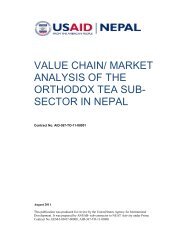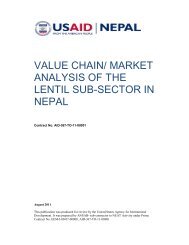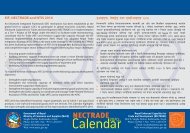value chain/ market analysis of the ginger sub-sector ... - Nepal Trade
value chain/ market analysis of the ginger sub-sector ... - Nepal Trade
value chain/ market analysis of the ginger sub-sector ... - Nepal Trade
- No tags were found...
You also want an ePaper? Increase the reach of your titles
YUMPU automatically turns print PDFs into web optimized ePapers that Google loves.
3.6 Vertical and Horizontal LinkagesVertical Linkages: Vertical linkages can be attained through cooperation between <strong>the</strong>different players or firms, and <strong>the</strong>y have <strong>the</strong> benefits <strong>of</strong> transferring skills from one player toano<strong>the</strong>r, as well as reducing transactions costs. Considering <strong>the</strong> <strong>ginger</strong> <strong>value</strong> <strong>chain</strong>, verticallinkages exist between cooperatives and growers in some pockets. In some cases, buyers areproviding credit while purchasing seeds. In <strong>the</strong> case <strong>of</strong> <strong>ginger</strong> candy, Himalayan Naturals hasprovided some technical skills and buyback guarantee <strong>of</strong> <strong>the</strong> products from one cooperative<strong>of</strong> Ramghat, Surkhet. There is good relationship seen between exporters <strong>of</strong> dry <strong>ginger</strong> andsome cooperatives <strong>of</strong> Palpa also. However, when looked nationally, <strong>the</strong>re is still a very poorvertical linkage between producers and traders.Horizontal linkages: This is <strong>the</strong> relationship among different players operating at <strong>the</strong> samelevel <strong>of</strong> a <strong>value</strong> <strong>chain</strong>. It can be seen at <strong>the</strong> producers level where <strong>the</strong>re are various <strong>ginger</strong>production groups in production pockets. Group members organize meetings periodically andshare information about <strong>the</strong> status <strong>of</strong> production, input procurements, and output <strong>market</strong>ing.Never<strong>the</strong>less, <strong>the</strong>re is little evidence <strong>of</strong> collective <strong>market</strong>ing practice in <strong>Nepal</strong>. As a result,<strong>the</strong>y do not benefit from horizontal linkages that can help <strong>the</strong>m generate economies <strong>of</strong> scale,which can improve <strong>the</strong>ir competitiveness and bargaining power. At <strong>the</strong> traders level, <strong>the</strong>y aremore united BMOs like JABAN (which fixes <strong>the</strong> price <strong>of</strong> products in weekly basis) andNGPTA.3.7 Value Chain GovernanceThe trading <strong>of</strong> <strong>ginger</strong> is mainly governed by Indian importers, as about 99 percent <strong>of</strong> <strong>the</strong> totalproduct is exported to India (ITC, 2010). There is greater complaint from traders towardsfarmers for supplying unclean and ungraded product.In most cases, <strong>the</strong> business relations between <strong>the</strong> various operational actors are <strong>of</strong> free <strong>market</strong>exchange. The uncoordinated transactions (arms-length spot <strong>market</strong> relationships) areprominent among <strong>the</strong>m. Contract farming is also not seen in <strong>ginger</strong>. There have been a fewinstances where <strong>the</strong> Indian buyers have <strong>of</strong>fered <strong>the</strong> national buyers some advance payment,which is transferred down to local traders. However, <strong>the</strong>re is rare incidence <strong>of</strong> advancepayment provision to <strong>the</strong> producers (Ghimire, 2009). The transaction pattern in export <strong>market</strong>is mainly on commission basis, where <strong>the</strong> commission agents charge 6-7 percent ascommission.Due to <strong>the</strong> lack <strong>of</strong> a proper <strong>market</strong> information system and minimal bargaining power,farmers are forced to sell <strong>the</strong>ir product at <strong>the</strong> price <strong>of</strong>fered by traders. <strong>Trade</strong>rs usually refer toIndian <strong>market</strong>s for price fixation. In some cases, <strong>the</strong>re are conflicts among <strong>the</strong> traders andexporters regarding payment and failure to keep <strong>the</strong>ir commitment.Overall, <strong>the</strong> governance <strong>of</strong> <strong>the</strong> <strong>ginger</strong> <strong>value</strong> <strong>chain</strong> is buyer-driven with minimum trustbetween various actors. <strong>Trade</strong>rs are always complaining that <strong>the</strong> farmers are not providingquality product while farmers are blaming <strong>the</strong> traders for <strong>of</strong>fering low prices.Value Chain/Market Analysis-Ginger 27






